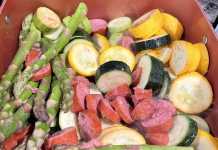You need to watch the new documentary, Fed-Up. It’s available on Netflix and is perfect for the next night when you and your partner are too tired to be productive post-bedtime. This documentary will give you plenty of food for thought (pun intended) and could actually end up making your night very productive if you end by setting new food goals for your family.

My husband and I pride ourselves on being very health-conscious. We are well aware that to many we seem quite rigid with our food rules, especially when it comes to our children. We try to only give fruit or nuts for snacks, we buy very little processed food, and we visit our farmer’s market weekly. We’ve never given our children Fruit Loops, soft drinks, or a hotdog (but don’t worry, the world made sure they got a hot dog). Some might say we are extreme, but after watching this documentary, I realize we need to go even further.
You see, as parents, we have a captive audience. Think about how hard it is to make better food choices yourself. Now think how much easier it would be if you had a loving being shopping for you, preparing your food, and only giving you healthy choices! Oh wait, that’s us. We are the parents and we do control (for the most part) what food comes in front of our children.
Why I’m anti goldfish
Why do I single out goldfish? Well, goldfish are the ubiquitous children’s snack. They serve them at the church nursery, at every daycare, at parties, etc. But I ask you, what about a goldfish makes it an appropriate snack for a child? It’s not a fish, and it is simple carbohydrates at best.

I try to avoid goldfish and all similar processed snack foods. I’m the mother who sends my kids with their own snack (usually fresh or dried fruit) to school or daycare settings. And I’ve always felt a little embarrassed. I’m not someone who pushes my views on others (this blog post excepted!). I have felt nervous saying, “Don’t feed my child goldfish, or any other processed food,” because inevitably I worry that I’ll indirectly be criticizing a choice they’ve made for their own children or children in their care.
That’s why I love this movie and other media like it. (Book rec: Food Rules: An Eater’s Manual) We all need to be pushed to think more critically about what we feed our children. Calories are not all the same. 100 calories of almonds goes into your body and the fiber in them ensures they are digested slowly with only a modest rise in blood sugar levels. 100 calories of a processed snack goes into your body, and the high sugar/low fiber combination mean that they are digested quickly with a high spike in blood sugar which causes the body to turn those calories straight into fat. We have an epidemic of childhood obesity in our country, and it’s because we are feeding our kids things that aren’t healthy.
Every parent could watch this documentary and leave with at least one thing they want to change for their family. I left feeling validated on my choice to not give my children juice (without the fiber of the real fruit, it’s just sugar), but ready to push myself on my own large morning glass of orange juice. At 5 and nearly 3, my older two are quickly nearing the age where they will call me out if I don’t practice what I preach.
I felt validated that most mornings we eat steel cut oats and that my children don’t have any form of sugar in their oatmeal. They’ve never had it there, and thus, they don’t notice its absence. But I felt challenged by how often I bake and offer my kids a dessert. I don’t want them to grow up expecting a dessert after every meal, which is a sugar addiction I myself am currently trying to break. (Interesting factoid from the documentary: sugar is eight times more addictive than cocaine.)
As parents, we oftentimes want to cut ourselves some slack because parenting is SO hard. But I don’t think what we eat should be the shortcut. We all love our children, but those of us without a medical degree, myself included, can’t fully appreciate what happens inside our child’s body after we let them eat that snoball, goldfish crackers, or Girl Scout cookies.
Now, I’m sure all these things are fine in moderation, but take a look back over the last week and think how many times, either in your care or out in the world, your kids have had an unhealthy snack. A good number right? Society today is not on the side of healthy eating. These snacks add up inside our children and could be putting them on the path toward the many health complications that come from too much sugar and unhealthy fats.
We could all – government, schools, the medical industry, fellow parents – be doing more to better nourish our children. Watch the documentary and consider taking part in the 10-day Fed Up challenge! Our family is currently in the midst of this ten day sugar-free challenge. My hope is that it shows us how much sugar is in our daily diet and helps us break some bad habits (namely mine and my husband’s!) and replace them with healthier ones.

















Great post! You’re right, we shouldn’t feel ashamed to ask people not to feed children processed foods. The culture of marketed foods needs to be challenged.
I write about raising healthy eaters at my Greenbird Living blog as it is a real passion of mine. I have stepchildren and 90% of the time we have no control over what they eat (which is mostly processed stuff). So when they are at ours, I go all out and even eat better myself. No sugar, no snacks, no processed foods. All homemade, and heavy on the veggies!
Keep up the good work in your family, your children will thank you when they are older as health is the most precious gift we could ever have.
I agree on all accounts. It can be hard to be the one that is standing up to make a change–but I believe we need to model for our children to stand up for what we believe in. And I believe in eating healthy.
Most pediatricians I’ve asked do tell me to practice 80/20 – they say as long as 80% is healthy then 20% junk will have little to no effect on the body. I want my kids to be active and healthy but not thin. Since what our society considers overweight is really the weight that helps people live longer – survival trait. Also – they get their 20% junk because they can then eat anywhere in a pinch and it won’t make them violently ill.
Ugh. It’s this kind of blog post that ensures that the mommy wars are alive and well. You’re a better mom because you feed your child what you seem a superior diet. Blah blah blah.
My intent in writing this post was to highlight the Fed Up documentary and the good points it makes about trends in eating in America today. To say that society should strive to eat healthier, more natural foods is an argument I stand behind. I include myself in that category. It’s not about being better than another mom or family; in my mind it’s about being better yourself.
What are some on-the-go snack suggestions for babies & toddlers? We use Cheerios/gold fish/animal crackers as easy snacks to throw in the diaper bag that don’t have to be refrigerated. Our 10 month old can’t have some of the healthier snacks yet and our 2 year old even has a hard time with harder raw veggies (like carrots) or nuts.
For healthy snacks, fruit is my go-to. I don’t worry about refrigerating bananas, apple or pear slices, satsumas, etc. For toddlers/twos and up, walnuts, pecans, raisins, and dried figs are our standard.
You shouldn’t be embarrassed to pack your own snack (fruit) to school for your child. It’s sad how common it is in the USA to give children processed foods and desserts as a snack. I’m from Estonia, but I worked in the USA with children for a few years and I was surprised what children had for snack: “Fruit Snacks”, Goldfish, Cheerios, even cookies (regularly at a daycare). My pet peeve was the “Fruit Snacks”, because I was so mad at the misleading advertising that so many people actually seemed to believe. It’s nothing but a CANDY no matter what they call themselves or how organic or vegan they are or even if they add vitamins to the product! I also noticed how the marketing for any kind of product is really clever in the USA and people have really fallen for that. You should not feel guilty for not giving your child these snacks, but I understand it’s hard to go against the trend when it’s so ingrained in the society. Just know that it’s a peculiarity of the US (and maybe elsewhere too besides the US), but it’s not normal from the outside perspective. What children have as a snack in a daycare here is mostly fresh fruit and vegetables, such as slices of apple, carrot, rutabaga (swede), banana, radish etc and they love it. Never cookies, Goldfish, Cheerios, “Fruit Snacks” or the like. These particular brands are not even given to children at homes. Of course children eat processed foods here too, especially as they grow older, but at least there’s no “creative” marketing to fool people into thinking a gummi candy or a Goldfish is a snack!
It drives me nuts that churches give these as a snack, not giving it a second thought. “Don’t eat the meat if it causes your brother to stumble” and all. I feel like we can’t even take them. I almost wish Christians had kosher rules too.
It’s an easy snack for churches because they need something shelf-stable, easy to chew (nuts and raisins are a SIGNIFICANT choking hazard), budget friendly, and an overall crowd pleaser. I’m sure your church would be more than thankful for you to volunteer to provide fresh fruit, cut up, for every child in their nursery every Sunday morning. But, it’s easier to whine that they won’t go through all of the trouble, in top of watching your children for free.
Oh, and here is a list of the top most dangerous choking hazard snacks as food for thought (pun intended) for all of you nut and raisin sanctimommies
“Food is a common choking hazard. Many children do not chew their food well so they try to swallow it whole. Foods that are the most dangerous are round and hard. If your child is 4 years of age or younger either take extra safety measures or don’t feed the following foods to your children at all:
Hot dogs
Nuts and seeds
Chunks of meat or cheese
Whole grapes
Hard, gooey, or sticky candy
Popcorn
Chunks of peanut butter
Raw vegetables
Raisins
Chewing gum
Marshmallows”